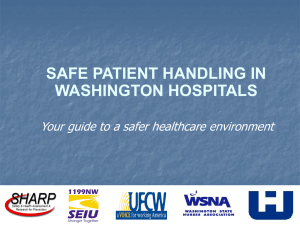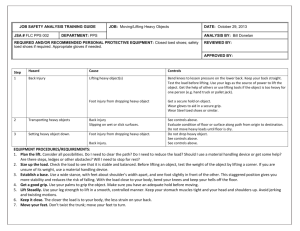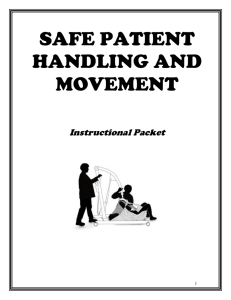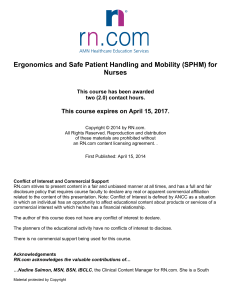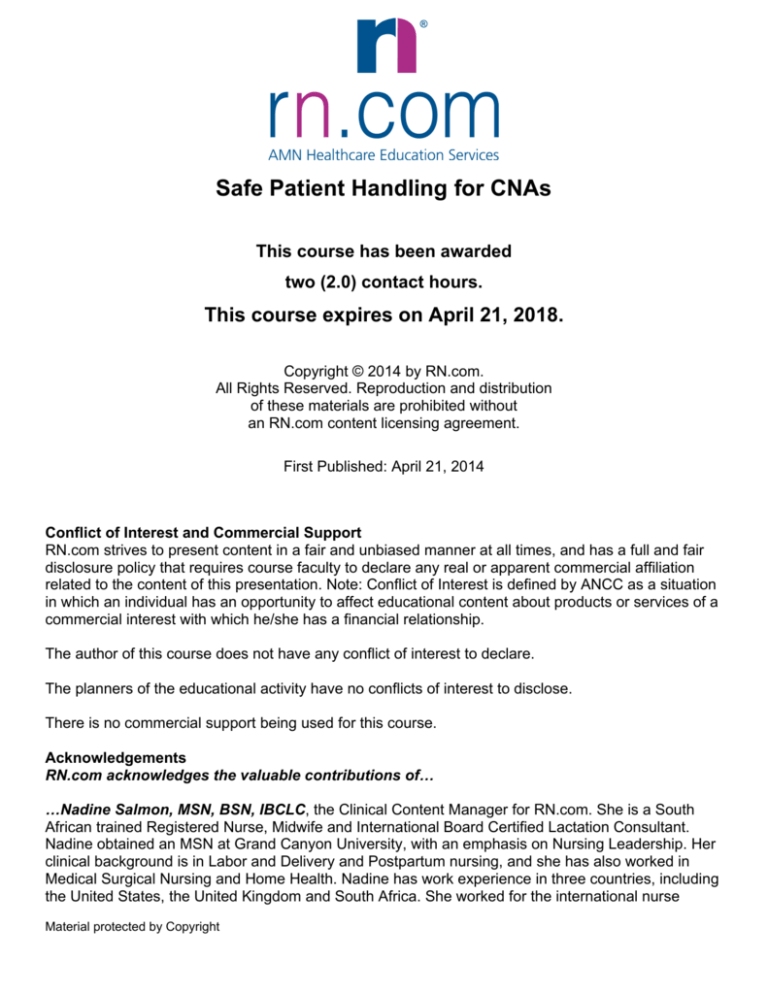
Safe Patient Handling for CNAs
This course has been awarded
two (2.0) contact hours.
This course expires on April 21, 2018.
Copyright © 2014 by RN.com.
All Rights Reserved. Reproduction and distribution
of these materials are prohibited without
an RN.com content licensing agreement.
First Published: April 21, 2014
Conflict of Interest and Commercial Support
RN.com strives to present content in a fair and unbiased manner at all times, and has a full and fair
disclosure policy that requires course faculty to declare any real or apparent commercial affiliation
related to the content of this presentation. Note: Conflict of Interest is defined by ANCC as a situation
in which an individual has an opportunity to affect educational content about products or services of a
commercial interest with which he/she has a financial relationship.
The author of this course does not have any conflict of interest to declare.
The planners of the educational activity have no conflicts of interest to disclose.
There is no commercial support being used for this course.
Acknowledgements
RN.com acknowledges the valuable contributions of…
…Nadine Salmon, MSN, BSN, IBCLC, the Clinical Content Manager for RN.com. She is a South
African trained Registered Nurse, Midwife and International Board Certified Lactation Consultant.
Nadine obtained an MSN at Grand Canyon University, with an emphasis on Nursing Leadership. Her
clinical background is in Labor and Delivery and Postpartum nursing, and she has also worked in
Medical Surgical Nursing and Home Health. Nadine has work experience in three countries, including
the United States, the United Kingdom and South Africa. She worked for the international nurse
Material protected by Copyright
division of American Mobile Healthcare prior to joining the Education Team at RN.com. Nadine is the
Lead Nurse Planner for RN.com and is responsible for all clinical aspects of course development.
She updates course content to current standards and develops new course materials for RN.com.
Purpose and Objectives
The purpose of this two contact hour course for CNAs is to provide an overview of safe patient
handling to protect CNAs from physical injury.
On completion of this course, the CNA will be able to:
1. Explain the importance of safe patient handling.
2. Discuss a Safe Patient Handling and Mobility (SPHM) Program.
3. Describe how to safely ambulate and reposition patients.
4. Describe how to safely transfer and reposition patients.
Introduction
Ergonomics is the scientific study of the relationship between work being performed (occupation/job),
the physical environment where the work is performed (workplace), and the tools (equipment) used to
help perform the work (Cohen et al; 2010).
Understanding ergonomics is important for CNAs as a large portion of patient care activities involve
lifting, moving or positioning patients and equipment. This places CNAs at high risk for physical injury.
The Goal of Ergonomics
The goal of ergonomics is to protect patients and healthcare providers against injury and maximize
safe handling of patients.
When patients are manually moved, their weight is an ergonomic hazard that can cause
musculoskeletal disorders in caregivers.
The goal of ergonomics is to modify the work environment to decrease the risk of injury to
CNAs.
Musculoskeletal Disorders (MSDs)
Musculoskeletal Disorders (MSDs) are a collection of disorders affecting muscles, nerves, tendons,
ligaments, joints, cartilage and spinal discs. MSDs usually present as low back pain, sciatica, rotator
cuff injury and carpal tunnel syndrome.
The majority of injuries are caused by over-exertion related to repeated transfer, repositioning, and
ambulation of patients (OSHA, 2011 in ANA, 2014b).
Musculoskeletal injuries in nurses have long been recognized as the result of patient handling tasks
(ANA, 2014). Of primary importance is back injuries and shoulder strains which can both be severely
debilitating. The American Nurses Association’s 2011 Health and Safety Survey found that nearly all
nurses have worked while suffering from musculoskeletal pain, and 80% said it was a frequent
occurrence (ANA, 2011).
Material protected by Copyright
Work-related MSDs such as back and shoulder injuries experienced by nursing staff are among the
highest of any occupation. Data collected in 2007 showed that nursing assistants, orderlies, and
attendants experienced a rate of MSDs seven times higher than the national MSD average for all
occupations (NIOSH, 2009 in TJC, 2012). Also, the nursing profession is typically listed as one of the
top 10 occupations with the highest annual incidence rates for sprain and strain injuries (TJC, 2012).
For many years, CNAs have been taught the correct way to manually lift or move patients, but
research now shows that there are safer ways to move patients that do not involve manual lifting.
Test Yourself
Musculoskeletal disorders:
A. Are mainly related to over-exertion.
B. Are lowest among healthcare workers.
C. Usually manifest in healthcare workers as headaches, knee joint problems and muscle
weakness.
The correct answer is: A. Are mainly related to over-exertion.
Manual Patient Handling: A Definite No-No!
The practice of manual patient handling (lifting, transferring, positioning, and sliding patients) puts
caregivers at risk for musculoskeletal injury.
Researchers have found that more than 80% of nurses are injured at some point, since there is no
safe way to manually lift or move a patient without mechanical assistance (Matz, 2005 in Cohen et al.,
2010).
High Injury Rates
According to 2009 data from the Bureau of Labor Statistics (BLS), registered nurses, nursing
assistants, orderlies, and licensed practical nurses suffered the highest prevalence and reported the
most annual cases of work-related back pain involving days away from work in the healthcare and
social assistance sector (CDC, 2014).
Healthcare workers and patients are at risk for injuries related to handling anywhere care is delivered,
including hospitals, long term care facilities, outpatient treatment centers, specialty care institutions,
and home care.
Injuries to Patients
Patients are also at risk of multiple injuries when they are manually lifted, moved or ambulated
(mobilized). There is the risk of pain and discomfort as well as anxiety with being moved. Patients
may be dropped during a lifting activity and sustain fractures, bruises or skin tears (Nelson & Baptiste,
2004 in TJC, 2012).
The use of transfer and lifting equipment can prevent many injuries, but must be used with care and
consideration for the type of movement and the patient’s characteristics, including weight and ability
to move independently. Injuries can occur when patient characteristics are not properly matched to
the piece of equipment used, or equipment is used that is not well maintained. Employees who have
not been trained to use a specific piece of equipment could injure the patient or him or herself as well.
Safe Patient Handling and Mobility (SPHM) Programs
Material protected by Copyright
Manual patient handling increases the risk of injury, pain, and negative health outcomes for patients.
Safe patient handling and mobility programs encourage the use of assistive devices to avoid manual
lifting.
Safe patient handling and mobility (SPHM) programs, if properly implemented, can drastically reduce
healthcare worker injuries (Nelson, 2006).These programs can also protect patients by reducing their
risk of pain, skin tears, bruising, and being dropped.
A SPHM program consists of mechanical equipment to lift and reposition patients, a safe-lifting policy,
employee training on using lift devices, patient care assessments, unit-based peer safety leaders,
and administrative support (Nelson, 2006).
The solution to the problems of manual patient handling lies in the development of safe
patient handling and movement programs (SPHM).
Components of a Safe Patient Handling and Mobility (SPHM) Program
Healthcare workers must be trained in correct body alignment and trained in the use and handling of
patient safety equipment. All healthcare workers should be encouraged to report unsafe working
conditions to management and promptly report any injuries to occupational health. Healthcare
workers should follow all procedures for lifting and the use of equipment (Occupational Safety and
Health Administration, 2012 in TJC, 2012).
Test Yourself
To protect against injury, healthcare workers should:
A. Be trained in SPHM programs.
B. Avoid moving patients without assistance from another person.
C. Refuse to accept any assignment that involves the movement of an obese patient.
The correct answer is: A. Be trained in SPHM programs.
Use of Unit Safety Leaders
A unit Safety Leader is usually an RN who is appointed as a Safety Leader or “peer expert.” The
Safety Leader is an informal unit leader who works together with all nursing personnel to implement
safe patient handling and movement practices.
The role of the unit Safety Leader includes:
•
Evaluating the use of patient care equipment
•
Responding to all unit safety concerns
•
Educating staff and monitoring staff adherence to the program
•
Evaluating the safe patient handling and mobility program
(U.S. Department of Veteran Affairs, 2014).
The Unit Safety Leader can also establish “safety huddles” to share information between staff that will
keep staff and patients safe (VA, 2014). These huddles are informal group or team meetings to
discuss the best way to move patients safely.
Material protected by Copyright
Development of Safe Handling Policies
It is recommended that all units:
•
Discourage manual lifting of patients
•
Have a no-lift policy
•
Require all staff to use appropriate assistive devices when moving, lifting or repositioning patients
Formation of Lift Teams
Another approach to reducing injuries during lifting and transfers is to use a team of specially trained
people who have the equipment to perform high-risk patient movements. The team most often works
the day shift and is available for scheduled and unscheduled transfers or lifts. Using a lift team can
limit injury to patients and CNAs.
Additional advantages to lift teams include:
•
CNAs who were previously injured can return to work and remain working with limited exposure to
high-risk activities.
•
Lift teams save nurses and CNAs an average of 1.5 hours per shift.
•
The fact that a hospital has a lift team can help recruit nurses and CNAs.
(ANA, 2014b).
Availability of Equipment
The success of many of the safe-lifting practices depends on having the right equipment, selected
with the input of the staff members who will be using it (ANA, 2014b).
Summary of Benefits of a Safe Lifting Program
Material protected by Copyright
(Table retrieved from OSHA, 2009)
Ambulation (Movement) of Patients
When the human body is immobile, it deteriorates quickly. Early and frequent mobilization
(movement) of a patient is important to maintain or regain health. In general, the earlier a patient is
mobilized, the better the patient outcome will be.
Safe Patient handling and mobility includes the following:
•
Moving the limbs of dependent, non-weight bearing patients to keep joint flexibility. This involves
taking limbs through their full range of motion.
•
Ambulating (getting up) patients as early and as often as possible to maintain mobility and bone
density.
Recent evidence suggesting the need for early and frequent ambulation applies even to some of the
sickest patients, such as ICU patients, who in the past were left immobile (Cohen et al., 2010).
Selecting Lifting and Transferring Devices
When you are deciding what assistive device to use to move or reposition your patient, always
consult with your assigned RN first. It is important to consider the following points before selecting a
piece of equipment:
1. The devices should be appropriate for the task that needs to be done.
2. The device must be safe for both the patient and the caregiver. It must be stable and strong
enough to secure and hold the patient.
Material protected by Copyright
3. The device must be comfortable for the patient. It should not produce or worsen pain, or bruise or
tear the patient’s skin.
4. The device should be managed with relative ease.
5. The device must be efficient in the use of time.
6. The maintenance on the equipment should be minimal.
7. The storage space for the equipment should not be too large.
8. The device must be moveable in a confined workspace.
9. The device should be able to be used for different patient needs.
10. The device must be able to be kept clean easily.
11. The device must be accessible.
12. The cost of the device and its maintenance costs should be reasonable.
(Matz, 2013)
Moving Patients Safely
Together with the RN, you can determine what movement is needed for your patient and decide on
the best way to achieve this. Identifying the most appropriate piece of equipment to accomplish the
move safely is important.
Always check with the RN to make sure the equipment you select is the most appropriate
device to move your particular patient with.
Transfer from Sitting to Standing Position
When you are planning to move your patient from a sitting to a standing position, you can consider
using an assistive device if your patient is:
• Co-operative
• Has some ability to bear weight but needs assistance moving
• Can sit up on the edge of the bed with or without assistance
• Is able to bend hips, knees, and ankles
• Transfers from bed to chair or chair to bed for bathing and toileting can be accomplished using a
wheel chair, Geri or cardiac chair
Points to Remember:
• Look for a device that has a variety of sling sizes and lift heights.
• Ensure device is rated for the patient’s weight.
• Electric / battery powered lifts are preferred to crank or pump type devices to allow smoother
movement for the patient, and less physical exertion by the caregiver (OSHA, 2009).
Patient Lifting
For patient lifting, a portable lift device (sling type) is recommended. This can be a universal /
hammock sling or a band / leg sling.
Material protected by Copyright
It is appropriate to use a lift device when lifting patients who are totally dependent, partial- or nonweight bearing, very heavy, or have other physical limitations. Transfers from bed to chair or chair to
bed for bathing and toileting can be accomplished using a wheel chair, Geri or cardiac chair. A
portable lift device can also be used after a patient fall.
Points to Remember:
• More than one caregiver may be needed.
• Look for a device with a variety of slings, lift-height range, as well as an emergency shut-off switch
and a support base that goes under beds. Having multiple slings allows one of them to remain in
place while the patient is in bed or chair for only a short period, reducing the number of times the
caregiver lifts and positions the patient.
• Portable compact lifts may be useful where space or storage is limited. Ensure device is rated for
the patient’s weight.
• Electric / battery powered lifts are preferred to crank or pump type devices to allow a smoother
movement for the patient, and less physical exertion by the caregiver (OSHA, 2009).
Test Yourself
A portable lift device is most suited for use in moving a patient who is:
A. Obese
B. Independent
C. Full weight-bearing
The correct answer is: A. Obese.
Ceiling-mounted patient lifts
These are mounted directly to ceilings or supporting structures attached to walls. Their drawbacks
include the cost to retrofit walls and ceilings and the fact that they cannot be moved from room to
room.
Repositioning in Chair
When repositioning partial- or non-weight-bearing patients who are co-operative, a Geri or Cardiac
chair can be used.
Points to Remember:
•
More than one caregiver is needed and use of a friction-reducing device is needed if patient
cannot assist to reposition self in chair. Wheels on chair add versatility.
•
Ensure that chair is easy to adjust, move, and steer.
•
Lock wheels on chair before repositioning. Remove trays, footrests, and seat belts where
appropriate.
•
Ensure device is rated for the patient’s weight.
Ambulation (Mobilizing)
Always use an ambulation assist device when moving patients who are weight-bearing and
cooperative, but need extra security and assistance when ambulating or getting up.
Points to Remember:
Material protected by Copyright
•
•
•
•
The device supports patients as they walk and push it along during ambulation.
Make sure the height is correct for patient before ambulation.
Make sure device is in good working order before use and rated for the patient weight to be lifted.
Apply brakes before positioning the patient in or releasing the patient from the device.
Lateral Transfers
Use devices to reduce friction when transferring a patient, such as a draw sheet or transfer cot with
handles.
These devices should always be used when transferring a partial- or non-weight bearing patient
between two horizontal surfaces (such as a bed to a stretcher or gurney while lying on their back) or
when repositioning patient in bed.
Points to Remember:
• More than one caregiver is needed to perform this type of transfer or repositioning.
• Additional assistance may be needed depending upon patient's needs. For example, additional
assistance may be needed for heavier or non-co-operative patients. Some devices may not be
suitable for bariatric surgery (stomach reduction) patients.
• When using a draw sheet combination, use a good hand-hold by rolling up draw sheets or use
other friction-reducing devices with handles such as slippery sheets. Narrower slippery sheets
with webbing handles positioned on the long edge of the sheet may be easier to use than wider
sheets. When using boards or mats with vinyl coverings and rollers, use a gentle push and pull
motion to move patient to new surface.
• Look for a combination of devices that will increase the patient’s comfort and minimize risk of skin
tearing. Make sure transfer surfaces are at same level and at a height that allows caregivers to
work at waist level to avoid extended reaches and bending of the back. Count down and
coordinate the transfer motion between caregivers.
Convertible wheelchair, Geri or cardiac chair to bed; beds that convert to chairs
These devices should be used for lateral transfer of patients who are partial- or non-weight bearing.
These aids eliminate the need to perform lift transfer in and out of wheelchairs. Can also be used to
assist patients who are partially weight bearing from a sit-to-stand position. Beds that convert to
chairs can aid repositioning patients who are totally dependent, non-weight-bearing, very heavy, or
have other physical limitations.
Points to Remember:
•
More than one caregiver is needed to perform lateral transfer. Additional assistance for lateral
transfer may be needed depending on patient’s status, e.g., for heavier or non-cooperative
patients.
•
Additional friction-reducing devices may be required to reposition patient. Heavy duty beds are
available for bariatric (stomach surgery) patients.
•
Always make sure the device is in good working order before using. Make sure the wheels on
equipment are locked.
•
Make sure transfer surfaces are at same level and at a height that allows caregivers to work at
waist level to avoid extended reaches and bending of the back.
Material protected by Copyright
Lateral Transfer in Sitting Position
The use of transfer boards (wood or plastic, and some with a movable seat) are useful aids to employ
when moving a patient from one place to another, when in the seated, upright position. Transfer
boards are most suitable for use when transferring (sliding) patients who have good sitting balance
and are co-operative, from one level surface to another (for example from a bed to wheelchair,
wheelchair to car seat or toilet). Can also be used by patients who require limited assistance but need
additional safety and support.
Points to Remember:
• Movable seats increase patient comfort and reduce incidence of tissue damage during transfer.
• More than one caregiver is needed to perform lateral transfer.
• Make sure clothing is between the patient’s skin and the transfer device.
• The seat may be cushioned with a small towel for comfort.
• This device may be uncomfortable for larger patients. Make sure the patient's weight is not more
than the maximum safety weight recommended for the device.
• The device is usually used together with gait belts for safety if the patient is very large.
• Make sure the boards have tapered ends, rounded edges to prevent injury.
• Make sure the wheels on bed or chair are locked and transfer surfaces are at same level.
• Remove lower bedrails from bed and remove arms and footrests from chairs as appropriate.
Test Yourself
The use of transfer boards are best for moving a patient from one place to another when the patient
is:
A. Uncooperative.
B. Seated in the upright position.
C. Immobile in the horizontal supine position.
The correct answer is: B. Seated in the upright position.
Transfer from Sitting to Standing Position
Lift cushions and lift chairs are useful devices to use when moving patients from sitting to standing
positions. These devices are suitable for patients who are weight-bearing and cooperative, but need
assistance when standing and ambulating. Can also be used for independent patients who need an
extra boost to stand.
Points to Remember:
•
Lift cushions use a lever that activates a spring action to assist patients to rise up. Lift cushions
may not be appropriate for heavier patients.
•
Lift chairs are operated via a hand-held control that tilts forward slowly, raising the patient.
Patients need to have physical and cognitive capacity to be able to operate lever or controls.
•
Always make sure the device is in good working order before use and is rated for the patient’s
weight to be lifted.
Transfer/Repositioning
The use of gait belts/transfer belts with handles is appropriate when transferring patients who are
Material protected by Copyright
partially dependent, have some weight-bearing capacity, and are cooperative. Transfers such as bed
to chair, chair to chair, or chair to car; repositioning patients in chairs; and when supporting patients
during ambulation.
Points to Remember:
• More than one caregiver may be needed.
• Belts with padded handles are easier to grip and increase security and control.
• Always transfer to patient’s strongest side.
• Use good body mechanics and a rocking and pulling motion rather than lifting when using a belt.
• Belts may not be suitable for moving heavy patients or patients with recent abdominal or back
surgery.
• Belts should not be used for lifting patients.
• Make sure the belt is securely fastened and cannot be easily undone by the patient during
transfer.
• Place a layer of clothing between the patients’ skin and the belt to avoid injury.
• Keep the patient as close as possible to caregiver during transfer.
• Lower bedrails, remove arms and foot rests from chairs, and other items that may interfere with
the transfer.
• For use after a fall, always assess the patient for injury prior to movement. If the patient can regain
a standing position with minimal assistance, use gait or transfer belts with handles to aid patient.
Keep back straight, bend legs, and stay as close to the patient as possible. If the patient cannot
stand with minimal assistance, use a lift device to move him or her.
Repositioning
The use of trapeze bars; hand blocks and push up bars attached to bed frames can make
repositioning so much safer for both the patient and the caregiver. These devices should be used
when a patient needs to be repositioned and is able to assist the caregiver during the activity. To do
so, the patient must have upper body strength and the full use and control of their extremities, be cooperative and follow instructions.
Points to Remember:
•
Patients use trapeze bar by grasping the bar suspended from an overhead frame to raise
themselves up and reposition themselves in a bed.
•
Heavy duty trapeze frames are available for bariatric (abdominal surgery) patients.
•
If a caregiver is assisting, make sure the bed wheels are locked, bedrails are lowered, and bed is
adjusted to caregiver’s waist height.
•
Blocks also enable patients to raise themselves up and reposition themselves in bed. Bars
attached to the bed frame serve the same purpose.
Conclusion
By paying attention to the physical needs of patients, the CNA can safely move, ambulate and
reposition patients without injury to themselves or to patients.
The use of assistive devices is important in protecting the safety and wellbeing of both caregivers and
patients. Work with your nurse to select the most appropriate assistive device to use when
considering moving or repositioning your patient. Always ask for assistance when needed and you
will safeguard yourself and others from injury.
Material protected by Copyright
References
American Nurses Association [ANA], (2011). 2011 ANA Health and Safety Survey. Retrieved
February 3, 2014 from: http://www.nursingworld.org/MainMenuCategories/WorkplaceSafety/HealthyWork-Environment/SafeNeedles/2011-HealthSafetySurvey.html
American Nurses Association [ANA], (2014a). Handle With Care Fact Sheet. Retrieved February 3,
2014 from: http://www.nursingworld.org/MainMenuCategories/ANAMarketplace/Factsheets-andToolkits/FactSheet.html
American Nurses Association [ANA], (2014b). Safe Patient Handling and Mobility: Inter-professional
National Standards. Retrieved February 3, 2014 from: http://nursingworld.org/SPHM-Standards
Brophy, M., Achimore, L. and Moore-Dawson, J. (2001). Reducing Incidence of Low-back Injuries
Reduces Cost, American Industrial Hygiene Association Journal, 62:508-11.
Buppert, C. (2013). Am I Required To Manually Lift Heavy Patients? Medscape: Legal & Professional
Issues for Nurses. Retrieved from: http://www.medscape.com/viewarticle/806550_2?nlid=31899_785
Centers for Disease Control & Prevention [CDC], (2014). Safe Patient Handling. Retrieved February
18, 2014 from: http://www.cdc.gov/niosh/topics/safepatient/
Cohen, M., Nelson, G. & Green, D. (2010). Patient Handling & Movement Assessments: A White
Paper. The Facility Guidelines Institute, April 2010. Retrieved Feb 3, 2014 from:
http://www.fgiguidelines.org/pdfs/FGI_PHAMA_whitepaper_042810.pdf
Matz, M. (2013). Safe Patient Handling Guidebook for Facility Champions/Coordinators. Veterans
Association, 2014.
Nelson, A. (2006). Safe Patient Handling and Movement. Springer Publishing Co: NY. Retrieved Feb
2, 2014 from:
Occupational Safety & Health Administration [OSHA], (2009). Ergonomics for the Prevention of
Musculoskeletal Disorders: Guidelines for Nursing Homes, OSHA 3182-3R 2009.
The Joint Commission [TJC], (2012). Improving Patient and Worker Safety: Opportunities for
Synergy, Collaboration and Innovation. Retrieved February 18, 2014 from:
http://www.jointcommission.org/joint_commission_publications_for_physicians.aspx
Trossman, S. (2014).The go-to nurses: Finding ways to keep long-time RNs. The American Nurse,
Feb 2014. Retrieved February 3, 2014
from:http://www.theamericannurse.org/index.php/2011/02/02/the-go-to-nursesfinding-ways-to-keeplong-time-rns/
U.S. Department of Veteran Affairs [VA], (2014).Safe Patient Handling. Retrieved Feb 3, 2014 from:
http://www.publichealth.va.gov/employeehealth/clinical_occhealth/safe_patient_handling.asp
Disclaimer
This publication is intended solely for the educational use of healthcare professionals taking this
Material protected by Copyright
course, for credit, from RN.com, in accordance with RN.com terms of use. It is designed to assist
healthcare professionals, including nurses, in addressing many issues associated with healthcare.
The guidance provided in this publication is general in nature, and is not designed to address any
specific situation. As always, in assessing and responding to specific patient care situations,
healthcare professionals must use their judgment, as well as follow the policies of their organization
and any applicable law. This publication in no way absolves facilities of their responsibility for the
appropriate orientation of healthcare professionals. Healthcare organizations using this publication as
a part of their own orientation processes should review the contents of this publication to ensure
accuracy and compliance before using this publication. Healthcare providers, hospitals and facilities
that use this publication agree to defend and indemnify, and shall hold RN.com, including its
parent(s), subsidiaries, affiliates, officers/directors, and employees from liability resulting from the use
of this publication. The contents of this publication may not be reproduced without written permission
from RN.com.
Participants are advised that the accredited status of RN.com does not imply endorsement by the
provider or ANCC of any products/therapeutics mentioned in this course. The information in the
course is for educational purposes only. There is no “off label” usage of drugs or products discussed
in this course.
You may find that both generic and trade names are used in courses produced by RN.com. The use
of trade names does not indicate any preference of one trade named agent or company over another.
Trade names are provided to enhance recognition of agents described in the course.
Note: All dosages given are for adults unless otherwise stated. The information on medications
contained in this course is not meant to be prescriptive or all-encompassing. You are encouraged to
consult with physicians and pharmacists about all medication issues for your patients.
Material protected by Copyright

